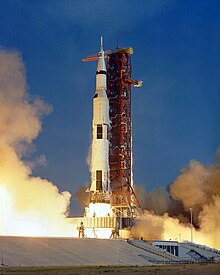Space vehicle
This article needs additional citations for verification. (February 2016) |

A space vehicle is the combination of a spacecraft and its launch vehicle which carries it into space. The earliest space vehicles were expendable launch systems, using a single or multistage rocket to carry a relatively small spacecraft in proportion to the total vehicle size and mass.[1] An early exception to this, the Space Shuttle, consisted of a reusable orbital vehicle carrying crew and payload, supported by an expendable external propellant tank and two reusable solid-fuel booster rockets.
Early spacecraft or space vehicles were sometimes known as "spaceships",[2][3] a term which comes from science fiction to designate a hypothetical vehicle which travels beyond low Earth orbit and is 100% reusable, needing only to be refueled like an airplane.
History
In the 1865 Jules Verne novel From the Earth to the Moon, successful attempts are made to launch three people in a projectile with the goal of a Moon landing. In 1880, The Pall Mall Gazette described Verne’s Columbiad as a "space-ship" — the first recorded use of this term.[4]
The concept of a "space ship" (or "rocket ship") was further developed in twentieth century
. By 2020, most SSTO developmental projects had failed with the exception of Skylon, which continues development.Current space vehicles
A majority of space vehicles currently in use are expendable, designed to carry a single payload into space but not for recovery and reuse. They typically consist of several stages which detach in sequence as the vehicle gains speed and altitude and propellant is exhausted.
to be a fully reusable orbital space vehicle.See also
References
- ^ "Expendable Launch Vehicle Investigations – Space Flight Systems". Space Flight Systems. Archived from the original on 5 September 2015. Retrieved 9 February 2016.
- ISBN 9780898754605.
- ^ "ДО СКОРОЙ ВСТРЕЧИ!" (in Russian). Archived from the original on 1 April 2021.
- ^ "| How Things Fly".
- ^ "PROPELLANTS". history.nasa.gov. Retrieved 9 February 2016.
